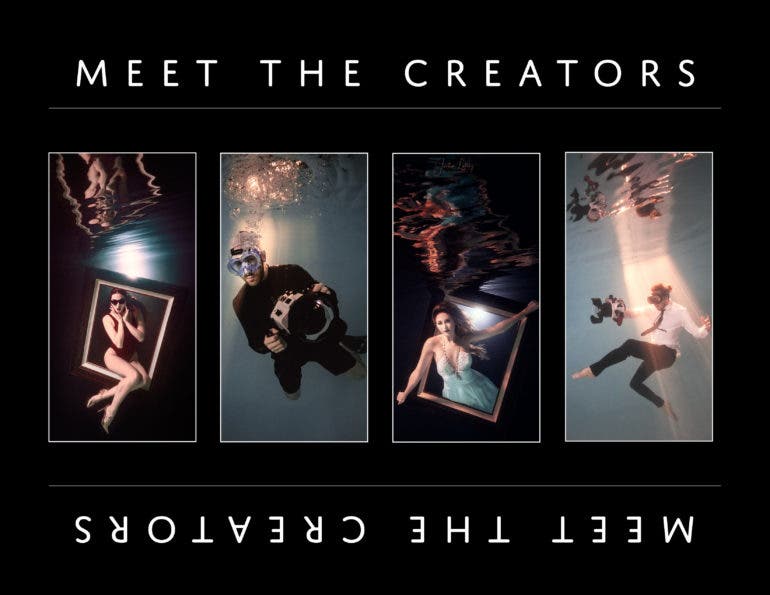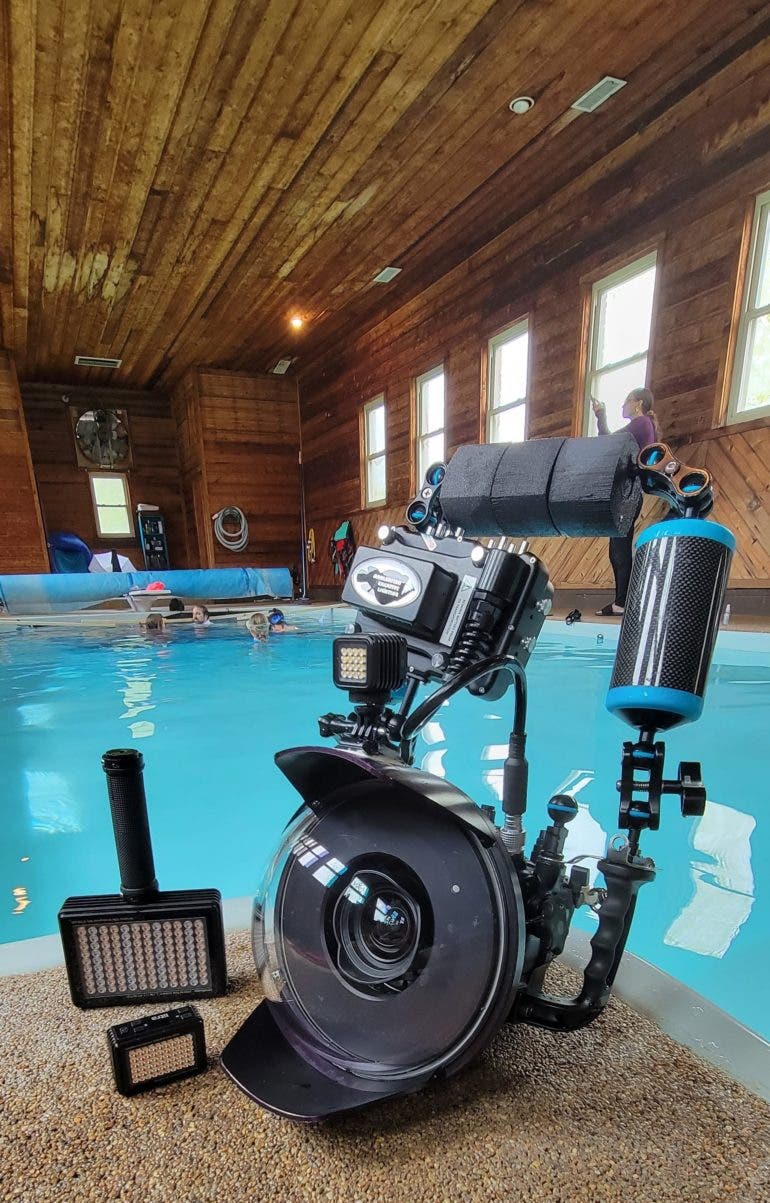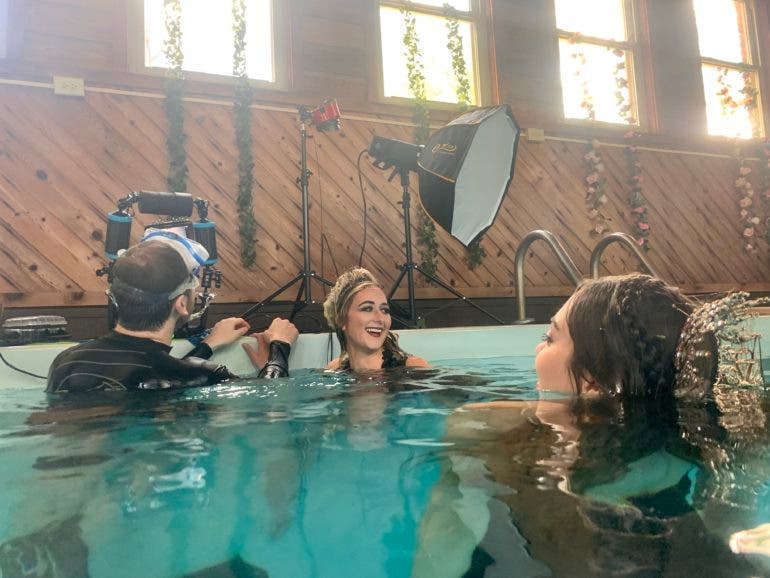Mermaids and Photographers Got Innovative to Make Team Submerge
We’re streaming daily on Apple Podcasts, Google Podcasts, Stitcher, Pocket Casts, and Spotify! You can also listen to it right here on The Phoblographer.
“Forming a synergy and shared understanding of the project’s goal is very helpful”, says Submerge team member Felicia. She’s the model featured in the ‘Springs Widow’ NFT, a project that came about from the collaboration of four friends. Each team member of Submerge has an area of specialization that came into play to create their latest Non-Fungible Token. We spoke to the team to understand how they created their newest NFT – ‘Spring’s Widow’.
NFTs aren’t technically new, but the craze surrounding them has peaked over the last year. If you’re confused about why they’re so popular, then you’re not alone. In March, a 21,069 pixels x 21,069 pixels file titled ‘The First 5000 Days’ was sold at a Christie’s auction for the whopping sum of USD 69 million. I consider myself a half-decent photographer, but I don’t think a single print of mine has sold for even 0.01% of that value.
If you look at the system behind NFTs closely, you’re pretty much paying for the bragging rights to the purchase of a digital file. A purchase recorded at a particular time and moment in history that can never be replicated. A digital file that, like a physical print, can be re-sold. Maybe I’m too old school to understand it yet, but I hope to get on this bandwagon sooner than later. I just hope the buzz around NFTs won’t dent sales of actual prints.
For the Submerge team, the plan was never to create this piece as an NFT. As the buzz increased, however, the team minted the production. They discuss the process and more in this in-depth interview.
Want to get your work featured? Here’s how to do it!
The Essential Gear Used by the Submerge team:

Justin from the Submerge team told us:
- Sony A7r III
- Nauticam housing
- Sony 12-24mm lens
- Strobes
- Octabox
- Radio transmitters
Lighting underwater is a combination of underwater strobes and above water strobes. As a key light, I usually have one topside strobe on a stand off to one side of the pool shooting through a big octobox. Then another topside strobe from behind the pool shooting down onto the subject to create seperation from the background. Finally, to further help separate the subject from the background, and to add a little bit of drama, I like putting an underwater strobe directly behind the subject to create an ethereal glow. The topside strobes are triggered via radio transmitter while the underwater strobes are triggered optically. Again, the Nauticam housing makes it possible to get copper wire connections as well as fiber optic connections from the camera out to various triggers.
The Phoblographer: Please tell us about yourself and how the Submerge team got into underwater photography.
Submerge: “Submerge” is a team of underwater creators consisting of Justin Lutsky (California) and Ben + Abbey Boutwell (Tennessee). For this project, the team worked with model Felicia Flaherty (Maryland). The four of us became friends and close collaborators over the years from a shared love of working in the water and creating underwater content.
Justin is an accomplished filmmaker and experienced underwater photographer/operator/safety diver based in Southern California. Justin has directed, edited, and produced multiple documentaries, music videos, and films and is passionate about creating “larger than life” experiences in his work. Ever since getting SCUBA certified years ago, he’s been obsessed with capturing underwater imagery and creating underwater art.
Ben is a professional above and underwater videographer and photographer based in Nashville, TN. He is co-founder of CreateWell LLC and is known for his visual effects and “out of the box” concepts and artistry. Ben has worked with brands such as Netflix, Doritos, Dole, Toyota, and more.
Abbey is a professional mermaid and underwater model based in Nashville, TN, with over 10 years of experience working in the entertainment industry. She creates above and underwater content with her husband, Ben, as CreateWell LLC. Abbey is the co-host of the “Everyday Mermaid Podcast” and has over 130K followers on social media.
Felicia is a commercial and fashion model as well as a professional mermaid. With over 1M followers on social media, she has over 7 years of experience in front of and behind the camera and specializes in underwater short-form content creation.

The Phoblographer: What gear do you use for your underwater work?
Justin: I shoot with a Sony A7riii in a Nauticam housing. I only use one lens underwater for portrait work, the Sony 12-24mm. Shooting in that range lets me get close to the model, which is ideal to minimize the amount of water between us and capture the cleanest possible image. The farther away you get, the image loses contrast and the potential for backscatter from particulates in the water increases. The main drawback to shooting with a lens this wide and close is that it’s easy to distort models limbs and features. I have to pay particular attention to keeping the subject near the center of the frame and coaching them into poses that are as parallel to the sensor as possible. Avoiding things like reaching or pointing legs directly toward the camera helps a lot.
The Nauticam housing is also important as every single camera function on the body is mapped to an external button on the housing in an intuitive way. Operating becomes muscle memory, and oftentimes, I’m adjusting things on the fly from shot to shot. For example, I use flexible spot autofocus keeping the focus area over the model who moves around underwater, and with the Nauticam housing, I’m able to quickly snap shots and move that flexible spot in fractions of a second. Or quickly review an image and then make immediate adjustments to the aperture, shutter, etc., before snapping the next one. This kind of flexibility is key as so much about shooting underwater is quickly adapting to things beyond your control.
Lighting underwater is a combination of underwater strobes and above water strobes. As a key light, I usually have one topside strobe on a stand, off to one side of the pool shooting through a big octabox. Then another topside strobe from behind the pool, shooting down onto the subject to create separation from the background. Finally, to further help separate the subject from the background and to add a little bit of drama, I like putting an underwater strobe directly behind the subject to create an ethereal glow. The topside strobes are triggered via a radio transmitter, while the underwater strobes are triggered optically. Again, the Nauticam housing makes it possible to get copper wire connections as well as fiber optic connections from the camera out to various triggers.

The Phoblographer: Was this idea born out of boredom during the lockdown last year? Did the Submerge team create it as an NFT, or was that something decided on later?
Abbey: We got together in April to simply just create, and this was one of the multiple sets we shot over that weekend. Once we started looking at the final images, we saw so much potential for this one in an NFT space that we decided to animate it.
The Phoblographer: Take us through how ‘Spring’s Widow‘ was produced by Submerge, from the idea until the execution.
Abbey: The piece “Spring’s Widow” was produced very organically. After scheduling our weekend of shooting, Felicia and I went to work to find wardrobes and props that inspired us. We went to multiple thrift shops in Nashville and found gowns, flower crowns, shoes, and accessories to wear underwater. Because a lot of things get ruined by the water, we don’t like to spend a lot of money on it, making thrift shops the best avenue. The weekend of the shoot, we grabbed any last-minute props that we wanted to use, including a fun fuzzy stool, glowing ball, and sticks (yes, real sticks!) from our backyard.
For the shoot, we clamped the sticks to a piece of 2×4 that was above the water and let the sticks hang at the top of the water. Felicia wore a stark white gown and held artificial flowers that we had painted black. For the black liquid coming out of her mouth, we bought black food coloring and would put a few drops in her mouth above water. Then, she would sink down with her mouth closed until she was posed and ready, after which she opened her mouth for the food coloring to come out, achieving a super cool and creepy effect. After editing the photo, Ben worked his magic in Adobe AfterEffects to animate the black liquid to create a loop of movement.

The Phoblographer: Given that it’s mostly done in a closed space / water tank / pool, where do you look for inspiration to make each underwater shoot look unique?
Abbey: This particular project was done in our Nashville pool studio, which is completely white. We kept this look for “Spring’s Widow,” but there are times we want a different vibe. When that happens, we use different colored waterproof backdrops, gels on lights, props such as underwater swings and greenery, etc., to keep it interesting.
The Phoblographer: I’m guessing there are a lot of retakes to get the perfect image during these shoots. How do you help the models feel at ease and get them to pose well each time they go under? Do they need extended breaks to recuperate and catch their breath?
Felicia: In order to make the team feel at ease about the shoot, it is useful to communicate the vision previously to shooting as well as continuously giving feedback in-between dives. Forming a synergy and shared understanding of the project’s goal is very helpful for the model to do her best with each posing session. If the models are in good spirits about the project and their abilities given the circumstances, the only limitations are physical inconveniences. Such as the water quality affecting eyes and sinuses or the models become cold from being immersed in a body of water lower than their temperature for a long period of time. Having a place to briefly rest in-between shots is very helpful for the longevity of achieving an image. Continuously sculling or treading water, especially in heavy dresses and fabrics, will lead to exhaustion much more quickly.

The Phoblographer: If there are lights on set for such shoots, what sort of safety measures are taken by Submerge to ensure everyone’s okay by the end of the day?
Justin: Most of the equipment is battery operated and totally safe to use in the water. If the camera housing floods or an underwater strobe fails, there’s no real safety issue, just a ruined piece of gear. The Nauticam housing I use has a vacuum seal and a leak detection system, so you know it’s watertight before it ever gets wet.

The topside strobes are also battery-operated most of the time, and on the rare occasion I use AC power for a strobe, it’s always plugged into a GFCI outlet. Sandbags are always necessary when placing any light stand near the edge of the pool as well.
The Phoblographer: Breath held, camera in hand – each time you go down to click, what’s going on through your mind? What sort of compensations need to be done for metering the light in these conditions?
Justin: Primarily, it’s being focused and in tune with the subject, trying to anticipate their movements and keep them framed in the most interesting way that doesn’t distort their features. I try to watch them as closely as possible, waiting for a great looking moment to pull the trigger. It’s very much like an underwater dance. The model leads, and I make micro adjustments in my position to compensate for their movement.
Overwhelming, though my mind slows down quite a bit each time we go down. It’s incredibly peaceful and all about being in the moment. The technical operation of the camera is all muscle memory, so my only job for the 30 seconds or so we’re underwater together is to be present and react to what unfolds.
I don’t meter the light at all. It’s entirely test shots, reviewing the images on the back of the camera, making adjustments, and repeating until things get dialed in.
The Phoblographer: Things obviously slow down under the water, but how do you get long hair and flow fabric to ‘cooperate’ and look good in such shots?
Felicia: Models can enter and exit the water in such a way that the hair will flow behind instead of in front of the face. However, hair is often uncontrollable. It can be coaxed into a different position if the model creates a current with their hand, pushing the hair in the direction they wish. Fabrics can be quite heavy in the water, and often assistance in manoeuvring the extra-long fabrics is incredibly helpful. If a production assistant can hold the fabric out of the shot, then let it go when the shooting begins, it will give a nice length of time while the fabric flows down. Similarly, the model can hold onto the fabric, then once in place, they can disperse it to the sides and let it flow freely.

The Phoblographer: Air bubbles in underwater portraits – hate them or love them?
Felicia: Air bubbles can be a very interesting and artistic addition to the shot. We personally do not prefer to see air bubbles from the nostrils, however controlled air bubbles from the mouth can be really interesting! Air bubbles also accentuate movement. For instance, dragging a hand from above the water to under the water creates a stream of air bubbles and can add extra pop and intrigue to an image.
The Phoblographer: Digital images have been around for a few decades, but the demand for NFT ownership is recent. What do you attribute this sudden craze to: buying virtual, merely digital media files over a signed print by a photographer?
Abbey: Everything is going digital, and now the art world is diving in (pun intended) to the digital craze. I think there is still a need for printed artwork and the NFT/digital art space is simply a new way to get your content out there. If my art speaks to someone, they should be able to collect it in any form, digital or not.

The Phoblographer: Photographers complain about the fluctuating cost of ‘gas fees’ for minting NFTs, but how different is this from material costs when it comes to photography?
Justin: Gas fees are just another material cost, in my opinion. The only difference is the constant fluctuation, but it’s essentially just another cost of doing business. Very similar to the costs that go into printing a photograph or creating a physical work of art. So far, we’ve been timing the minting of our NFTs to when the gas fees are lowest.
All images provided by CreateWell LLC on behalf of the Submerge team. Used with permission. Check out their website as well as those of Justin and Felicia. You can also bid on the NFT created by the Submerge team.